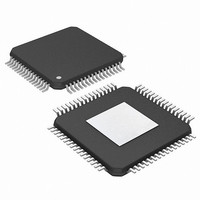PIC24FJ256DA206-I/MR Microchip Technology, PIC24FJ256DA206-I/MR Datasheet - Page 37

PIC24FJ256DA206-I/MR
Manufacturer Part Number
PIC24FJ256DA206-I/MR
Description
MCU PIC 16BIT FLASH 256K 64VQFN
Manufacturer
Microchip Technology
Series
PIC® 24Fr
Specifications of PIC24FJ256DA206-I/MR
Program Memory Type
FLASH
Program Memory Size
256KB (85.5K x 24)
Package / Case
64-VFQFN, Exposed Pad
Core Processor
PIC
Core Size
16-Bit
Speed
32MHz
Connectivity
I²C, IrDA, SPI, UART/USART, USB OTG
Peripherals
Brown-out Detect/Reset, GFX, LVD, POR, PWM, WDT
Number Of I /o
52
Ram Size
96K x 8
Voltage - Supply (vcc/vdd)
2.2 V ~ 3.6 V
Data Converters
A/D 16x10b
Oscillator Type
Internal
Operating Temperature
-40°C ~ 85°C
Processor Series
PIC24FJ
Core
PIC
Data Bus Width
16 bit
Data Ram Size
96 KB
Interface Type
UART, SPI, USB, I2C, RS-485, RS-232
Maximum Clock Frequency
32 MHz
Number Of Programmable I/os
23
Number Of Timers
5
Operating Supply Voltage
3.6 V
Maximum Operating Temperature
+ 85 C
Mounting Style
SMD/SMT
3rd Party Development Tools
52713-733, 52714-737, 53276-922, EWDSPIC
Development Tools By Supplier
PG164130, DV164035, DV244005, DV164005, AC164127-4, AC164127-6, AC164139, DM240001, DM240312, DV164039
Minimum Operating Temperature
- 40 C
Lead Free Status / RoHS Status
Lead free / RoHS Compliant
Eeprom Size
-
Lead Free Status / Rohs Status
Lead free / RoHS Compliant
- Current page: 37 of 408
- Download datasheet (4Mb)
2.7
If an ICSP compliant emulator is selected as a debug-
ger, it automatically initializes all of the A/D input pins
(ANx) as “digital” pins. Depending on the particular
device, this is done by setting all bits in the ADnPCFG
register(s), or clearing all bit in the ANSx registers.
All PIC24F devices will have either one or more
ADnPCFG registers or several ANSx registers (one for
each port); no device will have both. Refer to
(Section 23.0 “10-Bit High-Speed A/D Converter”)
for more specific information.
The bits in these registers that correspond to the A/D
pins that initialized the emulator must not be changed
by
communication errors will result between the debugger
and the device.
2010 Microchip Technology Inc.
the
Configuration of Analog and
Digital Pins During ICSP
Operations
user
application
firmware;
otherwise,
PIC24FJ256DA210 FAMILY
If your application needs to use certain A/D pins as
analog input pins during the debug session, the user
application must modify the appropriate bits during
initialization of the ADC module, as follows:
• For devices with an ADnPCFG register, clear the
• For devices with ANSx registers, set the bits
When a Microchip debugger/emulator is used as a
programmer, the user application firmware must
correctly configure the ADnPCFG or ANSx registers.
Automatic initialization of this register is only done
during debugger operation. Failure to correctly
configure the register(s) will result in all A/D pins being
recognized as analog input pins, resulting in the port
value being read as a logic '0', which may affect user
application functionality.
2.8
Unused I/O pins should be configured as outputs and
driven to a logic low state. Alternatively, connect a 1 kΩ
to 10 kΩ resistor to V
output to logic low.
bits corresponding to the pin(s) to be configured
as analog. Do not change any other bits, particu-
larly those corresponding to the PGECx/PGEDx
pair, at any time.
corresponding to the pin(s) to be configured as
analog. Do not change any other bits, particularly
those corresponding to the PGECx/PGEDx pair,
at any time.
Unused I/Os
SS
on unused pins and drive the
DS39969B-page 37
Related parts for PIC24FJ256DA206-I/MR
Image
Part Number
Description
Manufacturer
Datasheet
Request
R

Part Number:
Description:
Manufacturer:
Microchip Technology Inc.
Datasheet:

Part Number:
Description:
Manufacturer:
Microchip Technology Inc.
Datasheet:

Part Number:
Description:
Manufacturer:
Microchip Technology Inc.
Datasheet:

Part Number:
Description:
Manufacturer:
Microchip Technology Inc.
Datasheet:

Part Number:
Description:
Manufacturer:
Microchip Technology Inc.
Datasheet:

Part Number:
Description:
Manufacturer:
Microchip Technology Inc.
Datasheet:

Part Number:
Description:
Manufacturer:
Microchip Technology Inc.
Datasheet:

Part Number:
Description:
Manufacturer:
Microchip Technology Inc.
Datasheet:










